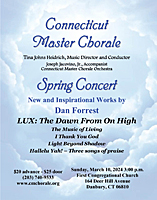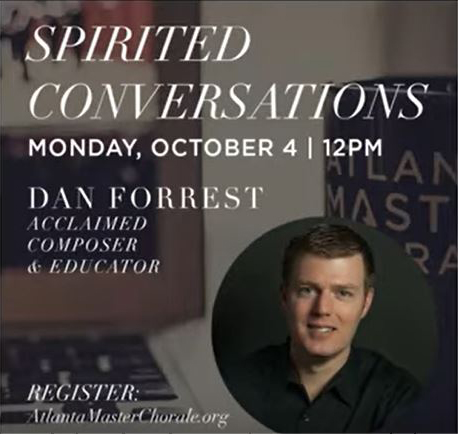LUX: The Dawn From On High
~ plus other ~
New and Inspirational Works
by Dan Forrest
Spring 2024 Concert Notes
Tina Johns Heidrich, Conductor
Joseph Jacovino, Jr., Accompanist
Connecticut Master Chorale Orchestra

Note:
Daylight Saving Time
begins on Concert Day
Sunday March 10, 2024 - 3:00 pm
First Congregational Church, Danbury, Connecticut
- Concert Photos - Concert Recording -
These concert notes were prepared by soprano Ginnie Carey.
Background on Dan Forrest
Growing up in rural New York State, the young Dan Forrest was fortunate to have excellent music teachers who nurtured his piano talent to the point that he played the Grieg Piano Concerto with the local symphony when he was a sophomore in high school. He holds both an undergraduate degree and a master's degree in piano performance as well as a doctorate in composition. Today his compositions are performed in leading venues around the world, but he was only 27 when his work Arise, ShineV was first performed in Carnegie Hall. His music spans a wide spectrum of genres and levels of difficulty, ranging from extended major works for chorus and orchestra and significant concert choral repertoire to accessible pieces for church and community choirs, as well as instrumental compositions ranging from works for wind ensemble to solo sonatas. He has been described as having "an undoubted gift for writing beautiful music that is truly magical", and is often admired for the texts, both the popular and the more obscure, he chooses for his compositions. When he is not creating expressive, emotional and inspiring music, this remarkable composer can be found spending time with his wife and three children, maintaining his extensive landscape gardens, participating in his church community, or playing Irish Traditional Music on the concertina.
Dr. Forrest was in his early thirties when Tina Heidrich first heard his music and introduced it to the Chorale. We were amazed by the maturity and beauty of his compositions and the creativity of his arrangements and continue to be awed by his increasingly vast collection of outstanding choral music. Our faithful audiences will remember his remarkable Requiem for the Living in 2015, Jubilate Deo in 2018, and In Paradisum, Te Deum and Psalm of Ascension in 2019. Our recent Holiday Prelude Concerts have also included his unique arrangements of traditional carols.
Meet Dan Forrest in this YouTube interview conducted by Atlanta Master Chorale Artistic Director, Eric Nelson. Dr. Forrest speaks about his upbringing and motivation, and explains what inspires him to compose such emotive choral music. At about 16 minutes in, he describes how he came to write i thank You God for most this amazing day which we will be performing at our concert.
This episode of "Spirited Conversations: Behind the Scores" was broadcast live on October 4, 2021.
LUX: The Dawn From On High

Dan Forrest
(b. 1978)
LUX, the Dawn From On High, a five-movement musical essay on the various facets of light, is the third major work from master composer Dan Forrest. Lux is the Latin word for light, and this evocation of shimmering light, unconditional love, deep peace, and heavenly bliss is classical composition at its best. Visually the composer was inspired by the light in Reims Cathedral in France and at Poulnabrone dolmen in the Burren, County Clare, Ireland. On a thematic and spiritual level, he was inspired by the profound texts which range from ancient liturgical chant and biblical scripture to contemporary poetry. His music stirs the heart and touches the spirit like the ethereal light of dawn. Dan Forrest writes that the title is meant to invoke the dual meaning of the text of the first movement, where the light of dawn gradually ascends into the sky, yet the Light of the world descends from the sky. The movements trace a symmetrical journey through time - from ancient prophecy, to today ("even after all this time"), and then back again; or from another perspective, from a day's dawn, through the sun's high point in the sky, and then to the setting of the sun on the horizon at the end of day.
I. Illuminare offers the promise of future light, and the hope of dawn. It begins with Luke 1:78-79, which ends with "Light from on high, come illuminate us" and continues with an Antiphon for Epiphany from the 14th century "You appeared as Light from light … Alleluia".
II. Lux in Tenebris is more assertive and uses contrasting meters and keys to underscore its texts about light shining in the darkness. "A light will shine on us today…" comes from a 10th century Introit for Christmas Dawn, and "The light shines in darkness…" is taken from John 1:5.
III. The Sun Never Says is American and Sufi Muslim poet Daniel Ladinsky's (b. 1948) extraordinary rendering of a poem by the great Persian mystic Hafiz (1325 - 1390) who was both a court poet and a teacher at a religious college. Mr. Ladinsky writes that his work with Hafiz "is an attempt to do the impossible: to render Light into words and to make the Luminous Resonance of God tangible to our senses". This poem was published in his popular 1999 book "The Gift". Dr. Forrest views this as "today" or "noon" in the journey of this work, and sees the sun as a metaphor for unconditional love that "lights the whole sky".
IV. Gloria in Excelsis continues Dr. Forrest's "light in the sky" motif with a joyous and soaring jazz-influenced setting of "Glory to God in the highest, and on earth, peace" from the Nativity story as told in Luke 2:14.
V. Creator of the Stars of Night originally comes from a 7th century chant, Conditor Alme Siderum, which was rewritten to fit the meters of classical Latin by Pope Urban VIII in 1632 and retitled Creator Alme Siderum. The first translation into English was made by the Anglican Priest John Mason Neale (1818 - 1866). This ancient evening hymn closes the day with the setting sun and provides a final unity between the multiple facets of light.

The Music of Living
The Music of Living was commissioned by the Cypress Woods High School Varsity Mixed Choir for performance at the 2011 Texas Music Educators Association Convention. Dr. Forrest remembers them as "a fine choir . who sent me the text they had found in a book - a rare moment of a provided text singing to me". His exuberant setting perfectly enhances the joy and optimism found in the anonymous poem.
i thank You God for most this amazing day
i thank You God for most this amazing day is not a typographical error, but an inspiring modernist free form poem written by the inimitable e.e.cummings, (1913 - 1962). The well-known, avant-garde poet from Massachusetts, also a novelist, playwright, and painter, was both deeply religious and unconventional in life, as well as in capitalization and syntax. This work was a commission from the Atlanta Master Chorale and Dr. Eric Nelson, their Artistic Director and Conductor, but Dr. Forrest was slightly reluctant to set this text because he felt there were already good settings in existence. He went on vacation and was riding his bicycle on a bridge over a marsh on a beautiful day when an egret rose out of the marsh and flew above it. At that moment Dr. Forrest relates that he immediately thought "i thank You God for most this amazing day", and was inspired by the marsh and the soaring egret to compose this amazing work. It premiered in Atlanta in October 2018 to great acclaim.
Light Beyond Shadow
Light Beyond Shadow was composed during the pandemic and inspired by a poem from the British author Paul Wigmore (1925 - 2014), a prolific poet who wrote lyrics for an opera as well as over 100 hymns. Dr. Forrest's exquisite setting enhances the themes of longing for light to break through darkness, and the celebration of light, joy, love, peace, and hope which are universal and timeless.
Hallelu Yah
I. Psalm 148
II. Psalm 147
III. Psalm 150
Notes from Dan Forrest:
My inspiration for these settings came from seeing the common word "hallelujah" transliterated more clearly "hallelu Yah", i.e. "praise YHWH"; these two words are an imperative (praise!) and the object of that praise (Yah, or Yahweh, the reverential Hebrew name of God). This opened up possibilities for both communicated meanings and speech accents.
I was also inspired to add percussion to the choir and piano, partly from reading in I Chronicles that Asaph, the ancient Hebrew worship leader and author of many Psalms, played the cymbals, and partly because Psalm 150 lists as much or more percussion than any other instrument family.
The last five Psalms all begin and end with "Hallelu Yah," and thus my settings of these three do the same.
The first movement sets portions of Psalm 148 about creation voicing God's praise, and weaves quotes of a related hymn tune throughout. Movement 2 turns its focus to people raising their voices alongside nature (from Psalm 147) and hints at the Psalmist's harp in its accompaniment. The third and final movement sets Psalm 150 as a dance in compound meter, with its well-known list of instruments joining in praise along with "everything that has breath".




